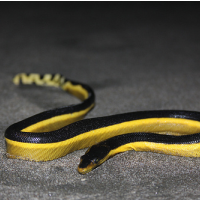“Incredibly Venemous” Sea Snake Comes Ashore in Southern California
 Yellow-bellied sea snake
Yellow-bellied sea snake
It might seem to the casual observer that Mother Nature is assaulting California, baking its countryside, unleashing pestilence and, most recently, sending “incredibly venomous” sea snakes to terrorize visitors at the shore. Well, maybe not everyone was terrorized.
“These are exciting times for these good observations,” Heal the Bay director of programs Meredith McCarthy told NBC Los Angeles.
McCarthy was exulting over the 2-foot-long yellow-bellied sea snake, the most plentiful snake in the world and a threat to humans, that was found last week wriggling on the beach at the Silver Strand in Ventura County’s city of Oxnard. It died shortly after being collected.
It was the first time in 30 years that Pelamis platurus, a descendant from Asian cobras and Australian tiger snakes, made an appearance in California. They ride warm currents in the Pacific and Indian oceans, in tropical climates, and last showed up during El Niño conditions similar to the present.
“There’s probably a lot of them swimming off the coast of Southern California right now,” Greg Pauly, herpetological curator at the L.A. Museum of Natural History, told the Los Angeles Times. Pauly, like McCarthy, is excited by the “insanely beautiful” snake’s appearance, since he gets to drop it in a bottle of formalin for preservation and put it on display.
The snakes live their entire lives at sea, eat small fish and eels, and can swim backward and forward. They are 10-45 inches long and tend to be “dark brown or black with a bright yellow or pale yellow underside which extends up the sides.” Heal the Bay says they have good hygiene:
“In order to remove foreign items from its body such as algae, barnacles, or other growths aquired by a life at sea, this snake ties a knot in its body and runs the knot from one end of the body to the other, cleaning the skin in the process. This technique is also used when shedding skin.”
California Herps says the snake’s “venom yield is low, but still considered dangerous to humans.” Heal the Bay, as enamored as they are of the creatures, considers them “highly venomous.” Everyone recommends not handling them.
Selfies, however, are OK. Heal the Bay has a “Report This Snake” wanted poster on its website that implores people to “take as many photos as possible, with cell phone, camera, whatever you have available to you,” which should be sent to them along with a location. The data will be used to confirm “this fascinating creature has been in our waters.”
Heal the Bay says there is certainly “no need to panic” should someone stumble upon one of the snakes in or out of the water, but, as Slate's Elliot Harmon pointed out, “That's just, like, their opinion man.”
–Ken Broder
To Learn More:
Venomous Sea Snakes Arrive with El Niño (by Kevin Roderick, LA Observed)
Blame El Niño for Poisonous Sea Snake Found on Ventura County Beach (by Larry Gordon, Los Angeles Times)
Climate Change and El Niño: A Double Whammy (Heal the Bay)
Yellow-Bellied Sea Snake—Pelamis Platurus (CaliforniaHerps)
- Top Stories
- Controversies
- Where is the Money Going?
- California and the Nation
- Appointments and Resignations
- Unusual News
- Latest News
- California Forbids U.S. Immigration Agents from Pretending to be Police
- California Lawmakers Urged to Strip “Self-Dealing” Tax Board of Its Duties
- Big Oil’s Grip on California
- Santa Cruz Police See Homeland Security Betrayal in Use of Gang Roundup as Cover for Immigration Raid
- Oil Companies Face Deadline to Stop Polluting California Groundwater





